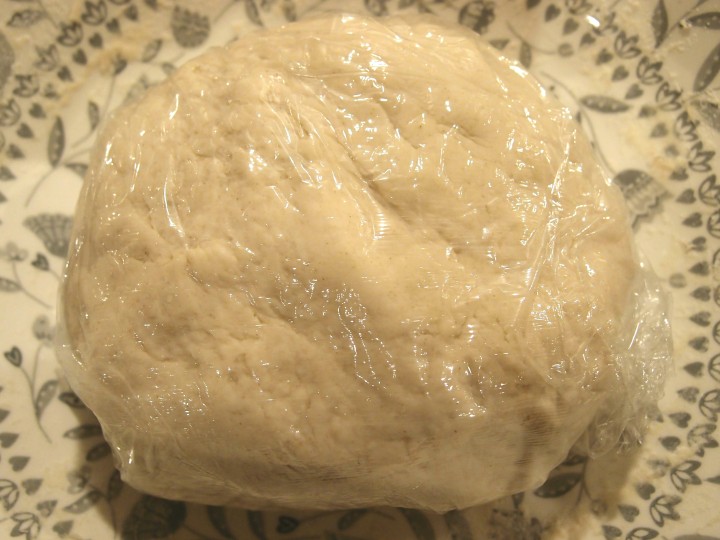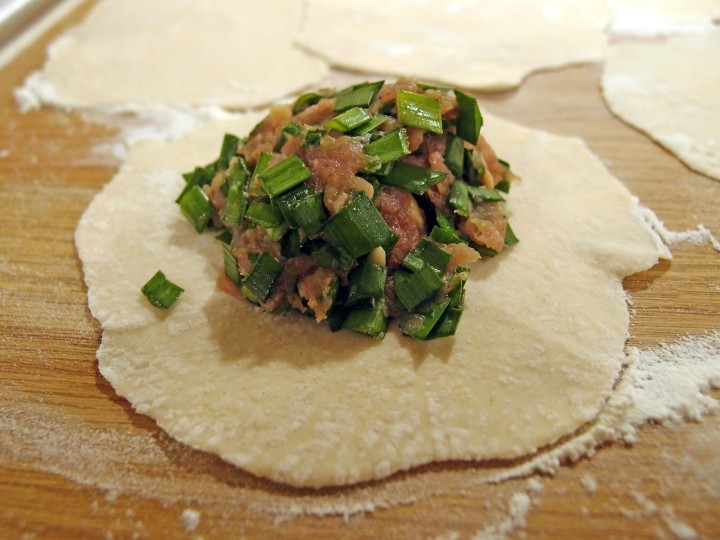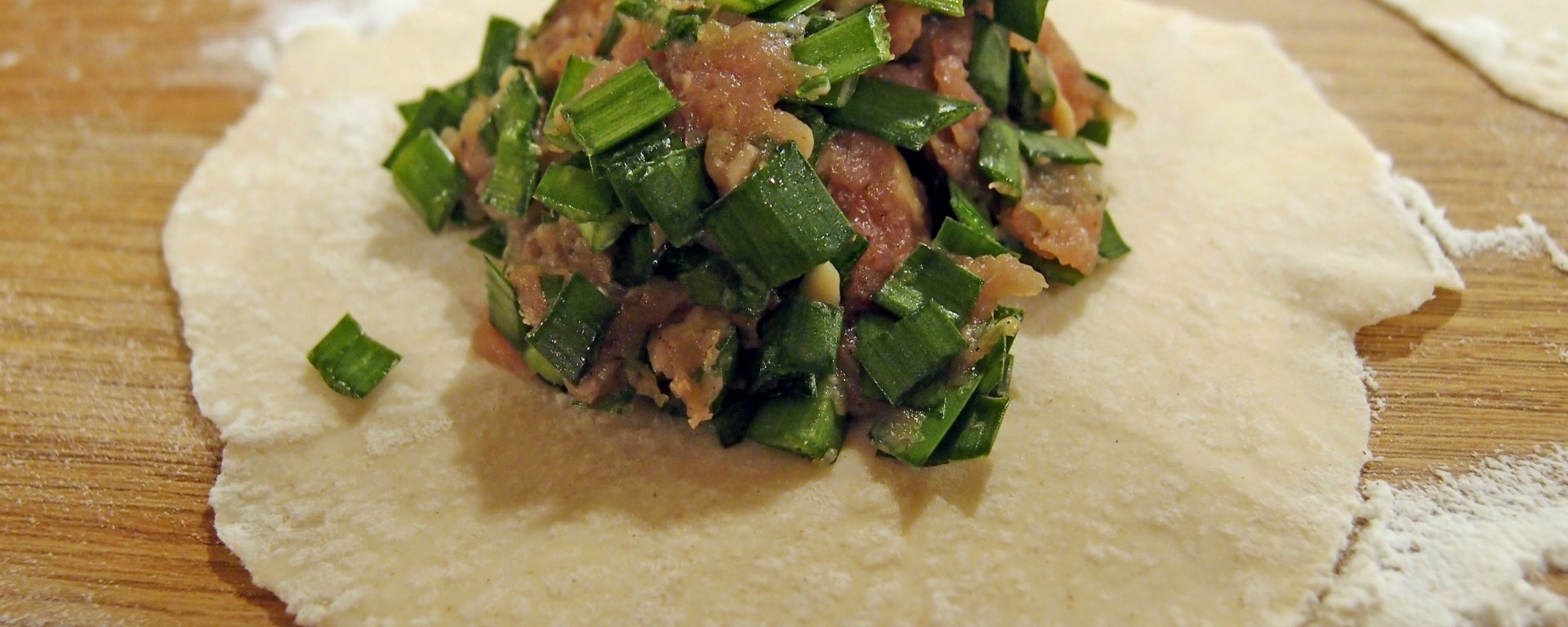It’s soon to be Chinese New Year, which means making dumplings (jiaozi – similar to gyoza or mandu). It’s more fun making this as a family, but with a few hours to spare over the weekend, it’s perfectly doable on your own.
One thing to note: these are probably bigger than any you’ve had in a shop. The philosophy behind dumpling-making is to have more filling and less skin, so bigger is better. This is also because we eat them by breaking each dumpling in two and dipping the centre in Chinese vinegar, so the size we’re aiming for is basically 2 mouthfuls per dumpling. And yes, that means the fillings are around twice the size of your normal dumpling from the shop.
You can make jiaozi with all sorts of fillings. My favourite is actually pork and fennel fronds, the fronds weren’t in season at the shops, so this version is with Chinese chives (jiu cai, aka kow choi).
The recipe serves 3-4, but only 2 on Chinese New Year! Traditionally, we’d put a coin into one lucky dumpling, but that’s not done here because we wanted all our teeth intact.
This includes instructions for both the fillings and the skin. Some people prefer to buy pre-made frozen dumpling skins, but the frozen skins are not as stretchy, and you’ll need to wet them with some water for them to seal properly. This means you can’t fit as much into the dumplings, and they are also more likely to break when you’re boiling them.
Again, with this type of recipe, the specific amounts are more fluid, so please use the below as a guide only, and hopefully there are enough photos to make this easy to follow.

Ingredients
2 cups of plain flour (300g)
500g of Chinese chives
500g of minced pork with high percentage of fat content
2 teaspoon of five spices powder
2 tablespoons of chopped/marinated garlic
1 teaspoon of soya sauce
A few drops of sesame oil
Salt to taste
1 egg (optional)
You’ll also need water and more flour for dusting.
Step 1: heat 1 cup of water, but not to the boil. Slowly stir this into the flour and start kneading. You will need to add a bit more water with this water to flour proportion, but add tiny amounts each time. In the end, the dough should not be dry and at the same time, will not stick to your hand.

Step 2: wrap the dough in cellophane and rest for at least 20 minutes. Meanwhile…
Step 3: wash the Chinese chives and dry it with paper towels. Leave to further air dry. This is to prevent the filling in becoming to watery.

Step 4: mix the pork, five spices, garlic, soya sauce, sesame oil and egg together in a bowl and stir (ideally in one direction) in a mixing bowl. Dust with salt and mix again. Keep refrigerated to stop the mix becoming too soft.
Step 5: once the dough is ready, dust the worktop with flour, unwrap the dough and hand roll it into one long “rope”. It should be around 1 inch in diameter. If you’re slower at making dumplings, then it’s worth splitting the dough in two before making the rope (and keep half wrapped), because you don’t want the skins to dry too much before you fold in the fillings.

Step 6: cut the dough into 1 inch chunks across. Dust with more flour.

Step 7: press down on each of the dough chunks so that they are flattened into little circles.
Step 8: roll these out with a rolling pin. Don’t press down much on the centre, but roll the edges out as flat as possible (the idea is that once you fold in the fillings, the sides are still quite thin). You’ll probably need to roll past each section twice. Now a dumpling skin is ready! Repeat for the rest of the dough.
Step 9: chop the Chinese chives and dry again with a paper towel. Now add this to the meat filling and stir thoroughly. Work quickly from now on, as the salt will draw out the water from the Chinese chives, so you want to make sure that the dumplings are made before the filling becomes too watery.

Step 10: spoon one stacked tablespoon of fillings into a skin and pat down. You want to try and fit as much in as possible! Stretch the opposite ends of the skin together and squash them together in the middle. Then squash the ends together and seal the dumpling. (If you end up with a small hole, dust dried flour over it and the skin may still hold.) Keep making them like this until you’re done.

Step 11: boil some water in a pan. Once it comes to a boil, drop in a batch of dumplings (as long as they are not all squashed together, that’s fine). Place on high heat without the lid on.

Step 12: Wait until it comes to a boil again, and stir if any of the dumplings start sticking to the bottom (it shouldn’t do). Add a cold water. Repeat with boiling/adding cold water three times in total, and the dumplings should be floating to the surface and cooked!

Step 13: spoon the dumplings out from the pan. Keep the floury “soup”. Serve with Chinese vinegar and (optional) garlic.

If you have too much flour/fillings, then you can create a “box” with the leftovers. Just roll out 1-2 extra large dumpling skin and fill with however much filling is left. If you create 1 large skin, then fold it over and close it like a Cornish pasty. With 2, you just stack them over each other to create one large round filled pancake. You can fry this – just drop it into a frying pan and brown both sides for roughly 5 minutes on each side.
Traditionally, you’d drink the “soup” after finishing your dumplings, but I guess it will taste just like slightly floury water to people who are not used to it, especially if you’ve managed to boil the whole lot without any dumplings breaking. Still, try it and let me know what you think.
And most of all, happy year of the monkey!
Follow @blenderbasil














I haven’t made jiao zi from scratch since I lived in China! This brought a smile to my face. I still eat it all the time, but it’s usually the frozen-to-steamer type or something I order in a restaurant. I should try making it again. 🙂
LikeLike
Glad you’re thinking of trying it again! There are some pretty decent frozen ones, the skin is always on the thicker side (and the fillings are small). : ) Hope you enjoy making yours!
LikeLike